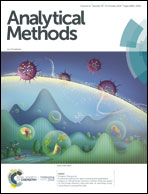Determination of bioavailable lead in atmospheric aerosols using unmodified screen-printed carbon electrodes†
Abstract
Atmospheric aerosol or particulate matter (PM) has huge potential to affect health and climate. The adverse effects of particulate matter exposure on human health depend on its size and composition, and toxic metals, such as lead, are some of the constituents. Conventional methods to detect lead include atomic absorption and flame emission spectroscopy, which require high cost and bulky instrumentation, generate noticeable amounts of residues and need trained technicians or users. In this study, a simple, portable and low-cost electrochemical method is reported to determine bioavailable lead in PM using an unmodified screen-printed carbon electrode (SPCE) based on square wave anodic stripping voltammetry performed on a portable potentiostat. The proposed approach has provided excellent sensitivity (21 ± 1 μA μg−1 L) with a detection limit of 0.023 μg L−1, low interference from other metals and a recovery of ca. 90%. The accuracy of the method was confirmed by comparison with inductively coupled plasma mass spectrometry. Moreover, the use of the SPCE exhibited good stability allowing quantification of lead in atmospheric PM collected in Goiania city (2016). The achieved concentrations of lead ranged from 0.04 to 0.21 ng m−3. Based on the reported data, the unmodified SPCE device has successfully demonstrated great selectivity and sensitivity for environmental analysis at trace levels, making possible the monitoring of bioavailable lead in PM samples.

- This article is part of the themed collection: Celebrating Latin American Talent in Chemistry


 Please wait while we load your content...
Please wait while we load your content...